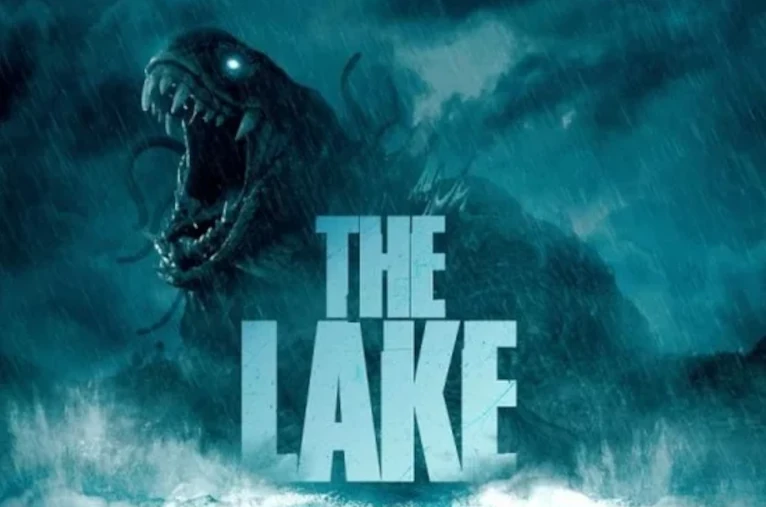The Lake
Written and directed by Lee Thongkham; cinematographed by Brandt Hackney; edited by Thongkham, Wang Cheng, Zhang Kun and Wang Nan; music by Bruno Brugnano; production design by Siam Boriraj; produced by Nimit Sattayakul and Nathaporn Siriphakcharath. Cast includes Wanmai Chatborirak, Sushar Manaying, Thanachat Tunyachat and Palita Chueasawathee. Released in the United States in Mar. 2023 by Epic Pictures Group. Running time: 104 minutes.
The Lake is a big-budget Thai eco-monster movie in which giant amphibious lake creatures rampage through a town in rural northeastern Thailand. The film has wonderful practical monster effects, but unfortunately little else to recommend it. To watch it is to be awed in equal measure by its creatures and its sheer ineptitude from a storytelling standpoint.
The movie is a textbook case of how not to craft a cohesive, engaging story. It’s filled with one-dimensional characters, setups that never pay off and unearned attempts at drama. It lacks narrative direction and a clear central theme. It relies on coincidences and contrivances to drive its plot and create conflict. It goes against all the time-honored rules of effective monster movie-making, revealing its creatures too early, too fully and without any sense of suspense or mystery. And its environmental message is so superficial as to make window dressing seem consequential.
We open amidst a thunderstorm on a lakeshore at night. Several villagers, apparently drawn to the shore by a sudden swarm of giant frogs (Don’t ask why they’re there; it’s never explained) discover a strange egg the size of a large watermelon and regard it with amazement. Then something huge begins to emerge from the water and advance toward the humans. (Don’t ask why this creature left her egg ashore to be found, or why the villagers are surprised by it if she’s been in the habit of doing this.)
The atmosphere, effects, camera work and character reactions are all great during this opening scene. The creature’s design is distinctive and convincing, and the film uses both low- and high-angle shots to superb effect in magnifying its towering presence. There’s one shot in particular that nicely homages Jurassic Park’s iconic T-Rex reveal.
The trouble is that there’s no buildup whatsoever to this monster’s reveal, the way there was with that of Jurassic’s Rex. Rather than slowly teasing us with brief glimpses and subtle hints that heighten our curiosity and make our minds race with possibilities, the movie shows us the whole monster right away, robbing us of the mystery and anticipation that come with a proper reveal. As a result,the monster soon becomes predictable and dull.
Another problem with this first scene is that it isn’t clearly connected to the rest of the story. We know it’s a prologue to the main events, but we’re given few clues as to when it takes place—and we’re left to guess at its significance to the overall story, since the rest of the film never refers back to it. Thus it’s an arbitrary spot at which to begin the plot, which could just as easily have begun at the outset of the post-prologue part of the movie.
The latter takes place in 2017, when a young farm girl named May (Wanmai Chatborirak) discovers another egg on the lakeshore. (This plot repeats itself a lot.) May is enchanted by the egg and rushes home with it, eliciting mixed reactions from her family. Her sensible older sister Lin (Sushar Manaying) desperately demands she return it, while her permissive older brother Keng (Thanachat Tunyachat) insists she be allowed to keep it.
We then cut to an exposition dump in which scientists studying the effects of climate change in the region inconsequentially talk ecology for a couple of minutes. One of them glibly mentions “high temperatures, typhoons or dying plants and animals,” but nothing is ever done with any of these themes. The movie doesn’t bother to make the connection between today’s environmental issues and the monsters’ presence, though my guess is that the monsters are supposed to be an allegory for animals forced out of their native habitats and into populated areas by human activities.
At just 15 minutes into the movie, we get our second dose of monster mayhem, perpetrated this time by a smaller, presumably juvenile, version of the great beast shown initially. It appears just as abruptly as the first one and is shown in broad daylight, the better to leach away any semblance of mystery or suspense.
As what little passes for a plot slogs onward, both the big creature and the smaller one make their tedious ways from the farming village to a nearby town, felling one insipid, cardboard cutout character after another along the way. Their arrival at the town just so happens to coincide with a big storm that knocks out cell service, cutting the town off from the outside world so that the story can be prolonged.
Other contrivances abound. A main character survives an attack that should have killed him because the movie needs him to stick around. A bus carrying evacuees comes to a halt because the streets are clogged with vehicles people left behind when they decided to flee the beasts on foot. Presumably they did so because either: 1) by some astonishing coincidence, their cars all simultaneously broke down, or 2) they decided to intentionally congest the road to introduce yet another plot complication.
Midway into the film, its environmental themes go from token gestures to heavy-handed melodrama, when an unseen link forms between one of the creatures and a human character whereby harming the creature also harms the human. Get it? We can’t hurt nature without also hurting ourselves.
Not knowing Thai, I opted to watch the English-dubbed version of this film. As fans of the Godzilla series are well aware, dubbing over a foreign film in English can be a comical proposition, with the need to match the new dialogue as closely as possible to the actors’ original lip movements often giving rise to awkward and unnatural lines. The Lake certainly has its share of such lines, but one stands out in particular. It comes during one of the monster attacks, when a character overhears the slaughter from behind some trees and the poor actress playing her is made to say, “There’s something going on there!”
The movie’s idea of character development is to assign characters random traits that hold no relevance to the plot and are never further developed (the brother’s drinking, a police inspector’s rebellious daughter, et cetera). We never come to care in the least about these characters or their ordeals, so when one of them suffers a tragic fate, we’re left unmoved, even though the scene is well acted and is clearly meant to evoke tears.
The movie has a number of parts like that: moments when the actors manage to do admirably well with what they’ve been given, but are still powerless to overcome the film’s glaring shortcomings. I’d love to see what this cast could do with a better script.
There was much initial excitement surrounding this movie, with some touting it as Thailand’s entrée into the kaiju genre. I’m just as eager as the next person to see Thailand get into monster movies, and my hope is that future offerings will have more going for them than this one.






